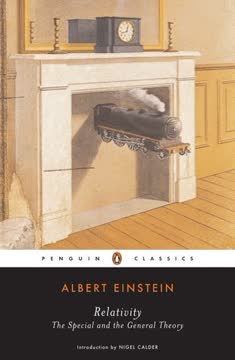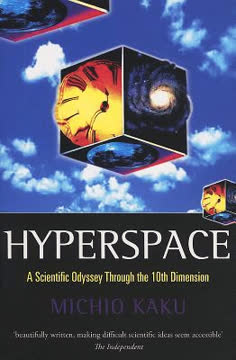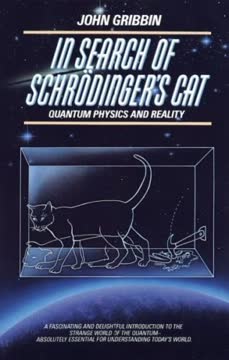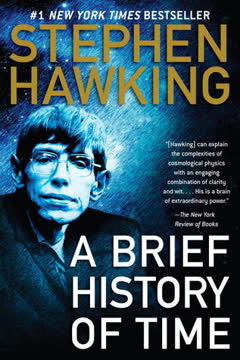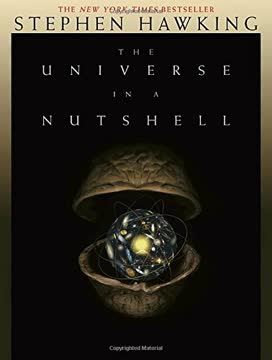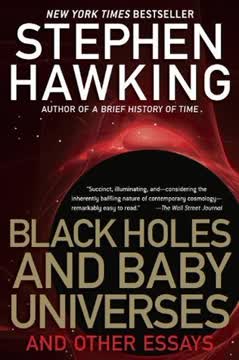Puntos clave
1. El Universo es Mucho Más Complejo y Misterioso de lo que Imaginamos
"¿Qué lugar, entonces, para un creador?"
La Complejidad Cósmica Revelada. El trabajo de Stephen Hawking desafía profundamente nuestra comprensión tradicional del universo, mostrándolo como un sistema intrincado y dinámico que supera con creces la capacidad humana de entendimiento. El universo no es una entidad estática, sino un mecanismo complejo en constante evolución, regido por leyes físicas detalladas.
Ideas Clave sobre la Complejidad Universal:
- El universo opera en escalas y principios que escapan a la experiencia cotidiana
- Las leyes físicas fundamentales están interconectadas de formas que apenas comenzamos a comprender
- Nuestra percepción de la realidad está limitada por nuestras capacidades sensoriales y cognitivas
Implicaciones Filosóficas. La complejidad del universo sugiere que los marcos religiosos y científicos tradicionales son insuficientes para comprender plenamente su naturaleza. El trabajo de Hawking implica que el universo podría ser auto-generado, desafiando creencias arraigadas sobre la creación y la intervención divina.
2. La Gravedad y la Expansión Remodelan Fundamentalmente Nuestra Comprensión del Origen Cósmico
"Un universo en expansión no excluye a un creador, pero sí limita cuándo pudo haber realizado su tarea."
Dinámicas Gravitacionales. Hawking explica que la gravedad no es simplemente una fuerza atractiva, sino un fenómeno complejo que moldea la misma estructura del espacio-tiempo. La expansión del universo, impulsada por interacciones gravitacionales, revela un paisaje cósmico dinámico en constante transformación.
Mecanismos de Expansión:
- Las galaxias se alejan unas de otras a velocidades proporcionales
- La tasa de expansión determina el destino final del universo
- Las fuerzas gravitacionales influyen en la formación de estructuras cósmicas
Perspectivas Transformadoras. La comprensión de la expansión universal desafía modelos cósmicos estáticos, sugiriendo que el universo no es una entidad fija, sino un sistema en evolución continua regido por principios matemáticos y físicos inherentes.
3. Los Agujeros Negros Desafían Todo lo que Sabemos Sobre la Física
"Los agujeros negros no son tan negros como se pintan."
Concepto Revolucionario. Los agujeros negros representan fenómenos cósmicos extraordinarios que cuestionan la comprensión tradicional de la física. No son simplemente objetos masivos que lo consumen todo, sino sistemas complejos que emiten radiación y que podrían transformar nuestra concepción del espacio-tiempo.
Características de los Agujeros Negros:
- Emiten radiación (contrario a teorías iniciales)
- Poseen propiedades matemáticas específicas
- Desafían los límites de la física clásica
- Representan posibles puertas para entender la mecánica cuántica
Cambio de Paradigma Científico. Los agujeros negros demuestran que nuestras teorías físicas actuales son incompletas, requiriendo enfoques innovadores que integren la mecánica cuántica y la relatividad general.
4. La Mecánica Cuántica Revela Profundas Verdades Sobre el Espacio y el Tiempo
"La distinción entre tiempo y espacio desaparece por completo."
Perspectiva Revolucionaria Cuántica. La mecánica cuántica introduce conceptos radicales sobre la naturaleza de la realidad, sugiriendo que el tiempo y el espacio son más fluidos e interconectados de lo que se entendía antes. La teoría desafía percepciones lineales de causalidad y dimensionalidad.
Ideas Cuánticas:
- El tiempo puede conceptualizarse como "imaginario"
- El comportamiento de las partículas desafía modelos deterministas clásicos
- La incertidumbre es un principio fundamental del universo
- Las observaciones influyen en los sistemas cuánticos
Implicaciones Filosóficas. La mecánica cuántica sugiere que la realidad es probabilística más que determinista, con una incertidumbre fundamental incrustada en el tejido de la existencia.
5. El Big Bang es Mucho Más que un Momento de Creación
"El comienzo del tiempo sería un punto regular y suave del espacio-tiempo."
Génesis Cósmica Reimaginada. El Big Bang no es un simple evento explosivo, sino un proceso complejo de mecánica cuántica que representa la transición del universo de un estado indeterminado a la existencia observable.
Características del Big Bang:
- Surgió de fluctuaciones cuánticas
- Siguió principios matemáticos precisos
- Representó una transformación, no una "explosión" literal
- El estado inicial fue altamente ordenado y uniforme
Matices Científicos. Comprender el Big Bang requiere ir más allá de modelos narrativos simplistas para captar los sofisticados procesos cuánticos que subyacen a la emergencia cósmica.
6. Las Teorías Científicas Evolucionan a Través del Cuestionamiento Continuo
"Una teoría científica es solo un modelo matemático que hacemos para describir nuestras observaciones."
Dinámica del Progreso Científico. El avance científico no se basa en certezas absolutas, sino en el cuestionamiento constante, la crítica a modelos existentes y el desarrollo de explicaciones más sofisticadas.
Principios de Evolución Teórica:
- Las teorías son provisionales, no permanentes
- El progreso científico requiere escepticismo
- Los modelos matemáticos ayudan a explicar observaciones
- Las teorías se refinan con nueva evidencia
Humildad Intelectual. Hawking enfatiza que el conocimiento científico es siempre provisional, demandando investigación continua y disposición para revisar lo que se sabe.
7. La Búsqueda de una Teoría Unificada de Todo Continúa
"La física, tal como la conocemos, terminará en seis meses."
Frontera Teórica. La búsqueda de una teoría que explique todas las interacciones físicas sigue siendo un desafío científico vigente, que requiere integrar la mecánica cuántica, la relatividad y otros principios fundamentales.
Desafíos de la Teoría Unificada:
- Requiere reconciliar teorías aparentemente incompatibles
- Demanda marcos matemáticos innovadores
- Necesita comprender efectos gravitacionales cuánticos
- Implica investigación interdisciplinaria compleja
Exploración Intelectual. La búsqueda de una teoría unificada representa el intento más ambicioso de la humanidad por comprender los principios fundamentales del universo.
8. La Percepción Humana es Limitada para Entender la Complejidad Cósmica
"El pasado es un país extranjero. Allí hacen las cosas de manera diferente."
Limitaciones Perceptuales. Las capacidades cognitivas humanas son inherentemente limitadas para comprender escalas cósmicas y fenómenos físicos complejos, lo que exige enfoques matemáticos y teóricos sofisticados.
Restricciones de la Percepción:
- Los sistemas sensoriales evolucionaron para la supervivencia, no para entender el cosmos
- Los modelos matemáticos trascienden la observación directa
- La intuición suele engañar en dominios cuánticos y cosmológicos
Perspectiva Epistemológica. Comprender el universo requiere ir más allá de la experiencia sensorial inmediata y desarrollar marcos conceptuales avanzados.
9. El Azar y la Probabilidad Moldean la Dinámica Universal
"Las leyes de la física no distinguen entre pasado y futuro."
Universo Probabilístico. La dinámica universal es fundamentalmente probabilística, con incertidumbre y fluctuaciones aleatorias desempeñando roles cruciales en la evolución cósmica.
Principios Probabilísticos:
- La mecánica cuántica introduce incertidumbre fundamental
- El comportamiento de las partículas es probabilístico
- La evolución cósmica involucra procesos estadísticos complejos
Implicaciones Filosóficas. El azar no es ausencia de orden, sino un principio organizador fundamental de la complejidad cósmica.
10. Nuestra Comprensión del Universo Está en Constante Transformación
"No puedes predecir el futuro, solo la probabilidad de diferentes resultados."
Paisaje Dinámico del Conocimiento. La comprensión científica del universo evoluciona perpetuamente, con cada descubrimiento revelando nuevas capas de complejidad y desafiando paradigmas existentes.
Características de la Evolución del Conocimiento:
- Los modelos científicos se refinan continuamente
- Nuevas tecnologías permiten observaciones más profundas
- Enfoques interdisciplinarios generan perspectivas novedosas
- La humildad intelectual es clave para el progreso
Aprendizaje Continuo. El universo sigue siendo un libro abierto, y cada avance científico ofrece destellos de su naturaleza profunda y misteriosa.
Última actualización:
FAQ
What's "The Theory of Everything: The Origin and Fate of the Universe" about?
- Overview: The book, authored by Stephen Hawking, explores the history and future of the universe, from the big bang to black holes.
- Content Structure: It is structured as a series of lectures that cover various cosmological concepts and theories.
- Main Themes: The book delves into the nature of the universe, the laws of physics, and the quest for a unified theory that explains everything.
- Purpose: It aims to make complex scientific ideas accessible to a general audience, providing insights into the workings of the universe.
Why should I read "The Theory of Everything: The Origin and Fate of the Universe"?
- Understanding the Universe: It offers a comprehensive overview of the universe's history and future, making it essential for anyone interested in cosmology.
- Accessible Science: Hawking presents complex scientific concepts in an understandable manner, making it suitable for readers without a scientific background.
- Intellectual Curiosity: The book stimulates curiosity about the fundamental questions of existence and the universe.
- Influential Work: As a work by Stephen Hawking, it provides insights from one of the most renowned physicists of our time.
What are the key takeaways of "The Theory of Everything: The Origin and Fate of the Universe"?
- Big Bang and Black Holes: The book explains the origins of the universe with the big bang and the nature of black holes.
- Unified Theory: It discusses the quest for a unified theory that combines quantum mechanics and general relativity.
- Time and Space: Hawking explores the concepts of time, space, and the possibility of a universe without boundaries.
- Scientific Inquiry: The book emphasizes the importance of scientific inquiry and the ongoing search for understanding the universe.
What are the best quotes from "The Theory of Everything: The Origin and Fate of the Universe" and what do they mean?
- "The universe would be neither created nor destroyed. It would simply be." This quote reflects the idea of a self-contained universe without a beginning or end.
- "The boundary condition of the universe is that it has no boundary." It suggests a universe that is finite yet unbounded, challenging traditional notions of time and space.
- "If we find the answer to that, it would be the ultimate triumph of human reason." This highlights the pursuit of a complete understanding of the universe as a pinnacle of human achievement.
- "The past is a foreign country. They do things differently there." This quote, borrowed from L.P. Hartley, underscores the book's exploration of time's direction and nature.
How does Stephen Hawking explain the Big Bang in "The Theory of Everything"?
- Initial Singularity: Hawking describes the big bang as a singularity where the universe's density and temperature were infinite.
- Expansion: He explains that the universe has been expanding since the big bang, leading to the formation of galaxies and stars.
- Time's Beginning: The big bang marks the beginning of time, as events before it have no observational consequences.
- Scientific Evidence: Hawking supports the big bang theory with evidence such as cosmic microwave background radiation.
What is the significance of black holes in "The Theory of Everything"?
- Gravitational Collapse: Black holes are formed when massive stars collapse under their own gravity, creating regions from which nothing can escape.
- Event Horizon: The boundary of a black hole, known as the event horizon, marks the point beyond which escape is impossible.
- Hawking Radiation: Hawking introduces the concept of black holes emitting radiation, challenging the notion that they are completely black.
- Cosmic Mysteries: Black holes are central to understanding the universe's structure and the laws of physics.
What is the "no boundary" proposal in "The Theory of Everything"?
- Finite but Unbounded: The proposal suggests that the universe is finite in extent but has no boundaries, similar to the surface of the Earth.
- Imaginary Time: It involves the concept of imaginary time, where time and space are indistinguishable, eliminating singularities.
- Self-Contained Universe: The universe is self-contained, without the need for external creation or destruction.
- Implications for Creation: This challenges traditional views of creation, suggesting a universe that simply exists.
How does "The Theory of Everything" address the concept of time?
- Time's Direction: Hawking explores why time seems to have a direction, known as the arrow of time, linked to the universe's expansion.
- Thermodynamic Arrow: The increase of disorder or entropy over time gives time its direction.
- Psychological Arrow: Our perception of time aligns with the thermodynamic arrow, as we remember the past but not the future.
- Cosmological Arrow: The universe's expansion provides a cosmological arrow of time, influencing the other arrows.
What role does quantum mechanics play in "The Theory of Everything"?
- Uncertainty Principle: Quantum mechanics introduces the uncertainty principle, affecting the predictability of events.
- Quantum Gravity: Hawking discusses the need for a quantum theory of gravity to understand the universe's early stages.
- Virtual Particles: The concept of virtual particles and their role in black hole radiation is explored.
- Unified Theory: Quantum mechanics is essential in the quest for a unified theory that combines all fundamental forces.
How does Stephen Hawking approach the search for a unified theory in "The Theory of Everything"?
- Grand Unified Theories: The book discusses theories that combine the weak, strong, and electromagnetic forces but not gravity.
- Challenges: The main challenge is integrating gravity, described by general relativity, with quantum mechanics.
- String Theory: Hawking explores string theory as a potential framework for a unified theory.
- Ultimate Goal: The search for a unified theory aims to provide a complete understanding of the universe's laws.
What is the anthropic principle as discussed in "The Theory of Everything"?
- Human-Centric View: The anthropic principle suggests that the universe's properties are as they are because they allow for the existence of intelligent life.
- Selection Principle: It implies that we observe the universe in a way that supports life because we are here to observe it.
- Cosmological Implications: The principle is used to explain why the universe appears fine-tuned for life.
- Philosophical Considerations: It raises questions about the role of observers in defining the universe's characteristics.
How does "The Theory of Everything" explore the relationship between science and philosophy?
- Scientific Inquiry: Hawking emphasizes the importance of scientific inquiry in understanding the universe.
- Philosophical Questions: The book addresses philosophical questions about existence, creation, and the nature of reality.
- Limits of Science: It acknowledges the limits of scientific models in answering "why" questions about the universe.
- Interdisciplinary Dialogue: Hawking encourages dialogue between science and philosophy to explore fundamental questions.
Reseñas
La teoría del todo es reconocida por su explicación accesible de conceptos cosmológicos complejos, aunque algunos lectores la encontraron desafiante sin conocimientos previos de física. Se valora el ingenio y la humildad de Hawking. El libro aborda los orígenes del universo, los agujeros negros y la búsqueda de una teoría unificada. Muchos críticos lo recomiendan para quienes sienten interés por la astronomía y la física, destacando su carácter conciso pero completo. Algunos sugieren que puede ser necesario leerlo varias veces para comprender plenamente su contenido.

